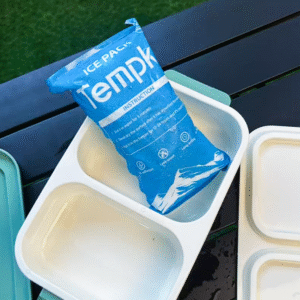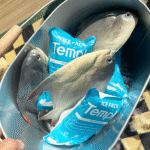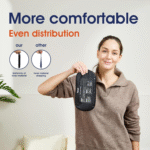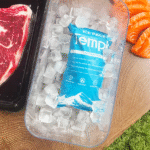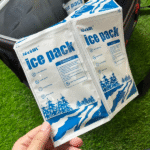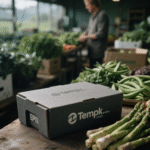paquete de 100 Paquete de hielo seco: 2025 Guía de la cadena de frío
Si envía mercancías sensibles a la temperatura, a paquete de 100 bolsa de hielo seco estandariza los paquetes, reduce la mano de obra, y extiende el tiempo de espera en las estaciones frías y cálidas. Este manual te ofrece las reglas breves, patrones validados, y los consejos de seguridad que necesita para realizar envíos congelados o entre 2 y 8 °C con confianza. Verás cómo dimensionar el refrigerante., evitar el shock de frio, y validar diseños sin gastar ni enfriar demasiado.
-
Por qué un conjunto masivo mejora la coherencia y el costo de las operaciones en varios sitios
-
Cómo ajustar el tamaño del refrigerante con un estimador rápido para carriles de 24 a 72 horas
-
que elegir: capas de hielo seco, paquetes de gel, o PCM para control de 2 a 8 °C
-
como etiquetar, respiradero, y capacitar a los equipos para que cumplan, embalajes seguros
¿Por qué elegir un paquete de 100 Paquete de hielo seco para envíos congelados de rutina.?
un paquete de 100 La bolsa de hielo seco reduce los errores y acelera el rendimiento mientras mantiene los puntos de ajuste más fríos por más tiempo.. Las unidades medidas previamente eliminan las conjeturas, para que el nuevo personal pueda seguir los SOP y alcanzar objetivos de tiempo dentro del rango. La compra al por mayor reduce el costo unitario y garantiza el inventario durante los picos. Muchos equipos ven paquetes más rápidos, menos reempaques, y temperaturas más estables durante los periodos de permanencia del fin de semana.
Piensa en cada unidad como un piso., “manta fría” flexible. Los paquetes planos cubren las tapas, paredes, y rincones por donde se escapa el calor. Esa cobertura suaviza los gradientes que provocan retornos o deshielos.. En la práctica, acondicionará previamente a -20 °C para carriles congelados o cerca de 0 a 5 °C para carriles refrigerados. La estandarización de recuentos por tamaño de caja acelera la formación, mejora el control de calidad, y facilita las auditorías. Estandarizar en un paquete de 100 bolsa de hielo seco También estabiliza la reordenación y la previsión..
¿Qué configuración ofrece el mejor tiempo dentro del rango para sus carriles??
Utilice tiras de tapa y piso además de pared para cajas de 12 a 24 litros; envolver cajas más pequeñas estilo burrito. Para cargas altas, una banda de 360° elimina los puntos calientes de las solapas. Combine un adorno pequeño con cobertura perimetral para manejar los picos de calor del último kilómetro sin sobredimensionar la caja. Comience simple, luego sintonícelo con registradores de datos. Esta configuración funciona mejor cuando cada caja utiliza un paquete de 100 bolsa de hielo seco paquete organizado por duración.
| Patrones de cobertura que reducen las fallas | Adaptar | Contar | Lo que significa para ti |
|---|---|---|---|
| envoltura de burrito | ≤10L cargador pequeño | 2–4 unidades | kit rápido; fuerte protección de los bordes |
| Tapa + piso + paredes | 12–Cargador de 24L | 4–6 unidades | Equilibra los gradientes verticales |
| 360° banda | Cargas útiles altas | 3–5 unidades | Elimina los puntos calientes del colgajo |
Consejos y consejos prácticos
-
Mariscos de la línea directa: Utilice una tapa de cobertura total, agregue una unidad adicional para la permanencia en la última milla.
-
Productos biológicos a 2–8°C: Combine tiras de pared con una tapa de PCM de +5°C para evitar golpes de frío.
-
Aumento de la temporada alta: Decenas preequipadas (10/20/30) entonces los equipos toman y se van según las horas de tránsito.
-
Fotos de control de calidad: Etiqueta cada imagen con el carril y el recuento exacto de tu paquete de 100 bolsa de hielo seco.
Caso del mundo real: Una marca de postres costeros cambió los gránulos sueltos por una cobertura plana. El tiempo dentro del rango mejoró en un día laborable, y el tiempo de empaque se redujo ~18 % con menos reempaques.
¿Cuántos de un paquete de 100 Paquete de hielo seco que necesitas por pedido.?
Tamaño de un paquete de 100 bolsa de hielo seco por ganancia de calor, no conjeturas. Una base rápida es de 5 a 10 libras de equivalente de hielo seco por 24 horas., ajustado para aislamiento y ambiente.. Agregue entre un 20% y un 30% de reserva para retrasos; restar si usas remitentes VIP. Condición previa: −20°C para congelados, 0–5°C para refrigerados. En duda, comience alto y afine, usando un paquete de 100 bolsa de hielo seco te permite hacer esto en incrementos limpios.
Traducir horas a equivalentes de días; multiplicar por una dosis del punto medio; luego modifique según la temporada y el tipo de caja. Mayor espacio libre, espuma fina, o los almacenes calientes aumentan la ganancia de calor. Un mejor aislamiento lo reduce. Valide con una prueba de perfil activo y ajuste una vez que confirme el exceso de enfriamiento.
Estimador rápido que puedes ejecutar en menos de un minuto
-
Días de tránsito = horas/24. 2) Masa base = 7,5 lb × días de tránsito. 3) Búfer = +25%. 4) Factor VIP = −15–30 %. Ejemplo: 48 h carril, EPS estándar → ~ base de 14 lb → +25% ≈ 17,5 libras. Preequipar de 6 a 8 unidades planas por caja de 14 litros y validar con un registrador. El documento cuenta por SKU en su SOP como paquete de 100 bolsa de hielo seco incrementos para una fácil auditoría.
| El iniciador cuenta por tamaño y duración del remitente | 24 H | 48 H | Para ti |
|---|---|---|---|
| 8–12L 2–8°C | 24 H: 3–4 | 48 H: 5–6 | pequeños kits de comida, diagnóstico |
| 12–18L 2–8°C | 24 H: 4–5 | 48 H: 7–8 | Tamaño de parcela común |
| Congelado ≤−15°C | 24 H: +25% | 48 H: +50% | Pre-condición a −20°C |
paquete de 100 Paquete de hielo seco versus paquetes de gel versus PCM: cuál gana?
Utilice un paquete de 100 Paquete de hielo seco para carriles congelados., PCM para temperaturas ajustadas de 2 a 8 °C, y packs de gel para rutas cortas refrigeradas. El hielo seco ofrece puntos de ajuste más fríos y una mayor duración.. Los PCM bloquean un rango estrecho, simplificar el papeleo, y reducir el shock de frío. Los paquetes de gel son de bajo costo para entrega local. Para escalar, a paquete de 100 bolsa de hielo seco mantiene la dosificación repetible en todos los sitios.
Muchos equipos combinan estrategias: un pequeño adorno de hielo seco para los picos de calor, PCM a +5°C en la tapa para mayor precisión, y tiras de pared planas para cobertura. Ese cóctel reduce el desperdicio y al mismo tiempo protege los SKU críticos.
Ayuda a la decisión: selección de refrigerante según necesidad
-
Necesidad por debajo de −15°C? Elija una cobertura equivalente a hielo seco.
-
Necesita +2–8°C para productos biológicos? Utilice tapas y tiras de pared de PCM.
-
Alimentos refrigerados locales? Los paquetes de gel son suficientes si está en tránsito. <24 H.
-
Catálogo mixto? Estandarizar la cobertura, variar la tapa.
Seguridad, etiquetado, y cumplimiento de un paquete de 100 bolsa de hielo seco
Trate un paquete de 100 Paquete de hielo seco como cualquier solución de hielo seco.: respiradero, etiqueta, y entrenar. Los paquetes deben ventilar co₂; nunca sellar herméticamente. Marque “Hielo seco/dióxido de carbono, sólido,"UN1845, y masa neta. Capacitar al personal, use guantes y gafas aislantes, y ventilar las salas de embalaje.
Separe el producto del refrigerante con un espaciador para evitar golpes de frío o quemaduras por congelación.. Utilice monitores de CO₂ donde almacene o manipule refrigerante a granel. Publique ayudas de trabajo de una página para que cada turno maneje los controles de aceptación de la misma manera.. Mantenga un inventario paralelo para que cada estación pueda extraer de una paquete de 100 bolsa de hielo seco sin demora.
2025 tendencias: como un paquete de 100 La bolsa de hielo seco se adapta al futuro.
En 2025, Los cargadores emparejan un paquete de 100 bolsa de hielo seco con envases más inteligentes. personaje + Los híbridos PCM reducen la masa de refrigerante. Las pruebas de perfil de parcelas como la 7E se convierten en punto de referencia. Los registradores de datos y sensores de CO₂ de bajo costo impulsan una iteración más rápida y menos reclamos. Estandarizar en torno a un paquete de 100 bolsa de hielo seco simplifica los manuales en todas las regiones.
¿Qué hay de nuevo a un vistazo?
-
personaje + híbridos PCM: Reduzca la masa de refrigerante mientras protege los bordes y las tapas..
-
Kits del tamaño adecuado: Haga coincidir el refrigerante con el volumen de carga útil para reducir el peso reducido y el desperdicio.
-
Monitoreo de IoT: Alerta a los equipos sobre picos de calor y niveles de CO₂ antes del riesgo del producto.
Insight del mercado
Los equipos informan reducciones de dos dígitos en los retornos después de estandarizar los patrones de cobertura, y una caída mensurable en la mano de obra cuando se preequipan unidades en decenas. Los turnos de inventario mejoran, también.
Hoja de ruta de implementación para un paquete de 100 bolsa de hielo seco
-
Mapea tus tres carriles principales (horas, ambiente, aislamiento).
-
Elija un patrón de cobertura y alinee los recuentos con un paquete de 100 bolsa de hielo seco.
-
Unidades de prekit en decenas por duración (24/48/72 H).
-
Ejecute una prueba de perfil activo con dos variantes; mantener al ganador.
-
Publicar un SOP de una página y volver a capacitarse trimestralmente..
Enlaces internos recomendados
Autocomprobación rápida y fragmento de tamaño
Preguntas frecuentes
¿Cuánto dura un paquete de 100 la última bolsa de hielo seco en tránsito?
Con buen aislamiento, espere entre 24 y 72 horas. Carriles calientes o espuma fina acortan la duración; Las tapas VIP lo extienden. Validar con un registrador antes de escalar.
es un paquete de 100 Exceso de bolsa de hielo seco para equipos pequeños?
No. El volumen reduce el coste unitario y acelera la formación. Tienda plana, congelado, y desplegar según sea necesario.
¿Necesito etiquetas UN1845 si solo uso PCM o paquetes de gel??
No. UN1845 se aplica al hielo seco. Acondicionamiento y colocación de documentos fijos, y seguir las reglas del transportista.
¿Cómo evito el shock por frío para productos biológicos sensibles??
Utilice una tapa PCM de +5°C, Minimizar el espacio de cabeza, y preenfriar la carga útil antes del embalaje.
Resumen y recomendaciones
A paquete de 100 bolsa de hielo seco mejora la consistencia, acelera el embalaje, y protege el producto en rutas largas y calientes. Comience con una cobertura simple, tamaño por ganancia de calor, y valídelo una vez; luego escale con confianza.
Ejecute un piloto de un carril esta semana: elige un patrón, kit de decenas, registrar temperaturas, y publicar el SOP. Necesita ayuda para adaptar recuentos y patrones a sus cajas? Póngase en contacto con nuestro equipo para una sesión de tallas rápida.
Acerca de Tempk
Tempk diseña kits de cadena de frío pasiva para alimentos, farmacéutico, y materiales avanzados. Validamos contra perfiles de paquetería., refrigerante del tamaño adecuado, y publicar los SOP que los equipos realmente utilizan. Los clientes ven un tiempo dentro del rango más largo y un peso reducido con menos reempaques.
Listo para estandarizar sus paquetes? Solicite ahora un plan específico para carriles.






